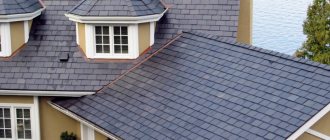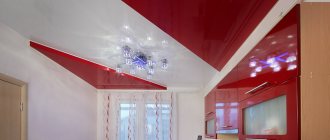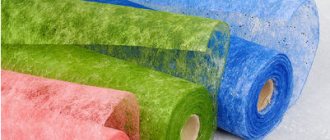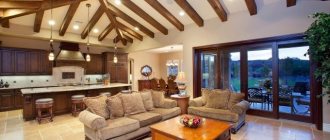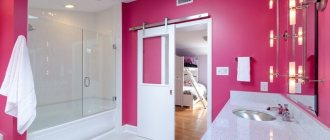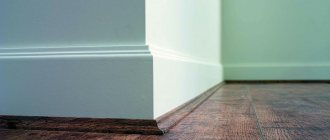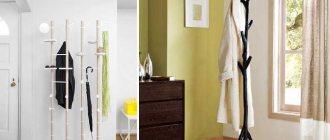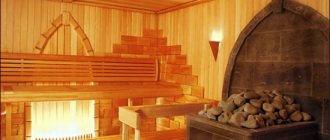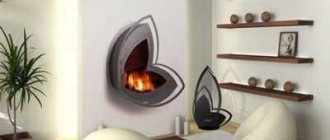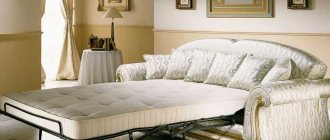Types of skirting boards for ceilings
Materials used for manufacturing.
| Skirting | Description | Photo |
| Polyurethane. | Durable, elastic, bends well and is suitable for decorating even rounded surfaces. It successfully replicates stucco molding, complex ornaments and patterns, and is suitable for painting with any paints. | |
| Wood. | Made from various types of wood. Such ceiling moldings look very expensive and add aristocracy to the interior. | |
| Made from polystyrene foam. | It is characterized by low price and easy installation. The only negative is that it is very fragile and does not bend at all. | |
| PVC (polyvinyl chloride). | Durable, easy to maintain and install. Such models are easy to cut, fit perfectly and can be painted multiple times in different colors. | |
| Polystyrene. | Extruded polystyrene plinth fits perfectly to the wall and ceiling. It washes well and is also easy to paint. | |
| Duropolymer. | Eco-friendly, hard material, resistant to mechanical stress and perfect for rooms with high humidity. | |
| Plaster. | It has an exclusive, aesthetic and rich look. Gypsum models are very reliable, environmentally friendly and fire resistant. |
Features of the ceiling plinth
The fillet differs from other types of wall-ceiling decor in that it has two surfaces that adjoin the wall and ceiling at an angle of 90 degrees. This ceiling plinth has an L-shape and is attached to the corner of the joint: one side to the wall, the other to the ceiling.
Calculate the exact cost of repairs using an online calculator
and receive a free detailed estimate for repairs
Calculate
Typically, designers choose fillets when decorating interiors in a classic style; such finishing looks no less successful in minimalist and modern spaces - in this case, a plank without relief patterns, smooth, is used.
Photo: remodelista.com
Photo: remodelista.com
Varieties of skirting board textures
The main types that are classified according to texture parameters:
- Smooth. It has a flat, smooth surface, without indentations, patterns or ornaments. It looks discreet and is great for decorating almost any interior.
- Extruded. It is distinguished by longitudinal recesses with ready-made grooves.
- Injection. It has a convex relief surface and has a granular structure. Such ceiling fillets are an independent decoration.
The photo shows an injection ceiling fillet in a beige shade.
Areas of product use
It must be taken into account that ceiling plinths differ not only in the material from which they are made, but also in their area of application. There are certain recommendations that allow you to ensure that the selected option fits well into the overall appearance of the room.
- PVC fillets. This option harmonizes best with the finishing of plastic panels. In addition, many varieties have a special groove for faster installation. In addition, PVC plinth for stretch ceilings is an excellent solution.
- Styrofoam. Most often used for finishing structures made from gypsum plaster boards. Excellent for walls and ceilings finished with putty or plaster. In this case, not glue, but a putty solution is used for fixation.
- Expanded polystyrene. A good solution for surfaces made of plastic and gypsum materials. In this case, a more suitable method of fastening is selected - glue or putty.
- Polyurethane. Universal products that are suitable for many materials. It happens that this is the only possible option when there are many curved areas.
- Gypsum skirting boards. Of course, this type is more suitable for classical compositions. Very often the finishing is done partially, for example, parts are installed exclusively in the corners. Fixation occurs on putty.
- Wooden crafts. This option is used quite rarely. It is better to combine it with wood materials to achieve greater harmony.
Photo gallery: various types of ceiling plinths in the interior (16 photos)
What sizes are there?
There are two main types: wide and narrow. Other tips for choosing the size will be listed below.
Narrow
Size range from 10 to 50 mm. Thin, laconic fillets are suitable for small rooms with low ceilings.
Wide
Allows you to visually smooth out corners and hide imperfections and unevenness of the walls. It has a range from 160 to 350 mm, and is most often used for decorating spacious rooms.
How to choose the width of the plinth
The length that is most often found on sale is 200 cm. Of course, other sizes are also available, allowing you to choose the best option. But more attention should be paid to the width of the product. So, many designers prefer wider options. This is due to the following factors:
- This fillet allows you to visually smooth out the corners. The room is not so rectangular, which reduces the irritation of the people in it.
- The wide ceiling plinth hides numerous irregularities and defects. For example, existing differences in height are most noticeable in the corners.
- This is an excellent solution when a suspended ceiling is installed on uneven walls.
A wide baseboard is an excellent option for high ceilings.
But keep in mind that you also need to take into account the height of the room. So, for low rooms, a less wide option is suitable, which will not look too bulky. The optimal size is thirty-five millimeters. For high ceilings, fillets are selected based on the fact that they will be more than sixty millimeters. A medium-width skirting board is a universal solution for any situation.
Varieties of fillet shapes
There are several types:
- Straight. The traditional and most common option, which is found in almost any interior.
- Flexible (soft). Such radius baguettes allow you to organize smooth shapes, thereby hiding imperfections, crooked corners and flaws in the ceiling space.
- With cable channel. They have additional internal space in which you can hide wires.
Each of the listed forms carries a certain focus and functionality.
Kinds
We can divide these products into several types according to many criteria: appearance, method of fastening, material of manufacture, cost, etc. But the most advantageous classification will be based on the material of manufacture, since the method of fastening, care features, and other factors depend on this.
| Material | pros | Minuses |
| PVC | Possibility of use in budget repairs | Not environmentally friendly, may allow moisture to pass through |
| Polyurethane | Practical, easy to install | Fairly high price, heavy weight |
| Styrofoam | Cheap, easy to use | Turns yellow over time |
| Gypsum | Gives a noble look to the room, is durable | High price, you can’t do without a specialist during installation |
| Expanded polystyrene | Practical, relatively low price | Toxic, there are some difficulties in care |
| Tree | Ecologically pure | expensive |
Baguettes are made from different materials
Let's take a deeper look at the advantages of all types, and the difficulties that can await us in use.
- PVC This material is often used in the design of ceilings. It is quite easy to install and does not require special care. It also has a low cost, which allows it to be used for budget repairs. Compared to other cheap materials, this one is the most durable and long-lasting.
PVC baguettes are very often used. They require minimal maintenance and are easy to install - Polyurethane is also a fairly popular material to use. It is easy to install and allows you to implement intricate ideas, as it bends easily and lends itself well to any processing. It can be painted with any type of paint and subjected to wet cleaning - it will not absorb water and will not become a breeding ground for mold. But with a lot of weight, you should take a responsible approach to the method of fastening. This baguette can be painted in any color
- Foam plastic (polystyrene) Such baguettes break records in use. Their cheapness makes them accessible to everyone, they also have a wide variety, are easy to use and care for, and do not mold. However, polystyrene foam also has a number of disadvantages: it looks cheap, is not moisture resistant, and turns yellow over time. Therefore, foam moldings for your ceiling need to be updated periodically, and this happens quite often.
- Expanded polystyrene (extruded) Belongs to the same group as polystyrene foam - polystyrene. The differences between them are in the production method and technical characteristics. They have a common base, so they both have a low price (polystyrene in this tandem is more expensive). According to technical characteristics, this material is denser, it does not have voids inside that can be filled with moisture, so it is moisture resistant (unlike foam plastic). In general, this base is slightly different from the foam plastic considered, its characteristics are better and the cost is higher.
This baguette differs from foam plastic in that it is more moisture resistant - Gypsum One of the most expensive and elegant baguettes. You can use it to make stucco molding. Often used for pompous styles in the spirit of the Middle Ages. Its only disadvantages include its high price and weight. Often this option is replaced by polyurethanes. It will become cheaper and allows you to imitate gypsum stucco. But if you want to get as close as possible to the original, and not cheapen the appearance of the interior, plaster will be the best option
This baguette is the most expensive and elegant - Tree Finally we got to the most noble species. Wood is a pure environmental product. If you want to reduce the number of harmful parts in the finishing, choose wood. You can choose any variety: ash, pine, oak, etc. It is better to use such products in a room where most of the details are made of wood to complement the overall flow. This type of ceiling moldings has the highest price, but it is justified by the quality of the product.
Use wooden frames in rooms that use a lot of wood
What color are the skirting boards?
Colored fillets change the overall perception of the interior and the room as a whole. In addition, ceiling plinths can be painted independently in any color.
- White.
- Black.
- Gold.
- Brown.
- Beige.
- Grey.
- Chromium.
- Yellow.
- Blue.
- Green.
The photo shows a narrow yellow ceiling fillet in the dining room interior.
To visually expand the space, use baguettes that match the color of the ceiling; to increase the height of the room, use ceiling plinths that match the color of the walls.
How to cover a curtain rod with a ceiling plinth?
Ceiling curtains are an elegant addition to interior design. The apartment looks tasteful if you take care of every detail. Interior design will not be presented correctly when you do not use finishing elements or forget to hide unsightly components of the composition. Proper window design can be the most striking accent in decorating a room. Beautiful curtains will not fully fulfill their decorative role if they are hung sloppily. Use a ceiling plinth that will cover the curtain rod, masking any unsightly details.
The most beautiful interiors are those where individual elements form a harmonious whole. Decorators know that details are always important because they determine how the finished room will look. That is why it is worth taking care of the plinth, which will become the final element of a neat ceiling.
Design options and drawings
A huge variety of decor gives baguettes a more unique look.
- Stucco molding. Always looks expensive and respectable. It brings notes of antiquity and luxury with its appearance and is best combined with classic interiors.
- With inserts. Inserts can be made in various colors, for example white and gold or dark wenge and silver. They are selected in combination with the color of the ceiling or walls.
- Patterns and ornaments. They transform and enliven the ceiling space, deprive it of monotony and set a unified style for the room.
- Ladder. The original cross-section in the form of a ladder creates a stepped ledge, which is quite popular in the design of many interiors.
The photo shows a white wide ceiling molding in the shape of a ladder.
Baguettes with a variety of designs harmonize the decor, give the room a special character and simply look very impressive.
How to choose a surface texture
Depending on the type of surface, ceiling plinths are:
- smooth;
- with grooves and protrusions, for example, in the form of a ladder;
- with complex reliefs, stucco or carved (more often found among wood, plaster and their imitations).
The shape of the plinth is selected depending on the size and style of the room. For low rooms with a modern design, the simplest ones are suitable. Such models are universal and easier to clean, as they do not collect dust and dirt. This quality is especially useful for kitchen baseboards.
For large halls and living rooms, decorated in palace styles, lush and massive moldings with curls and decorations are suitable. Gilding or patina is appropriate.
The remaining options fall between these extremes.
Attention! With elaborate shapes, it is difficult to fit fillets in the corners. For such cases, special curved elements are often produced.
For what types of ceilings can decorative skirting boards be used?
The main types of ceiling coverings to which fillets are applied:
- Stretch ceiling. Such a plinth not only protects and hides cracks and gaps between the walls and ceiling, but is also a rather original element of decorative finishing.
- Suspended ceiling made of plasterboard. For plasterboard two-level or multi-level structures, almost any model will be appropriate. Skirting boards made of polyurethane or polystyrene look especially natural with suspended ceilings.
- Wooden clapboard ceiling. Wooden figured and carved fillets in combination with the identical texture of the ceiling look luxurious and are in perfect harmony with each other.
- PVC panels. Plastic baguettes are better suited here, as they will noticeably highlight and emphasize the design of the entire ceiling.
- Ceiling tiles. Skirting boards will not only complete the overall design, but will also greatly simplify the gluing of ceiling tiles along the edge of the ceiling.
The photo shows a wooden openwork baguette in combination with ceiling lining.
Such models create a single composition on the ceiling and an additional geometric effect.
The photo shows a two-level plasterboard ceiling structure with polystyrene baguettes.
Skirting to a suspended ceiling: selection features
The most important parameters to pay attention to:
- Lightweight material that will not weigh down the stretch ceiling.
- The surface of the plinth that is adjacent to the wall must be at least 2.5 cm.
- The material should be strong enough, but allow the baguette to bend.
- Using a gypsum baguette requires preliminary preparation.
VIDEO: How to glue a plinth to a suspended ceiling?
Ceiling plinth for suspended ceiling
Do you need skirting boards and how to attach them?
Photos in the interior of the rooms
Baguettes can become an indispensable and main decoration of any room.
Bathroom
Galleys allow you to beautifully decorate your bathroom, give it the desired appearance or set the style.
Kitchen
Classic simple ceiling models made of polyurethane or polystyrene, which are resistant to high humidity and are easy to clean, would be appropriate here. It is advisable to choose wooden skirting boards for the kitchen without unnecessary patterns and ornaments.
Living room
Baguettes can completely change the interior of the living room, create unusual color and shade combinations and simply decorate the ceiling space.
The photo shows a small room with ash-colored ceiling moldings.
Balcony
To decorate a small balcony, narrow baguettes are suitable, which will visually balance and balance the narrow space.
Children's
Properly selected baseboard colors will allow you to create a harmonious design for the nursery, create smooth color transitions on the ceiling and thereby add additional height to the room.
Unusual Design Ideas
Let's look at a few ideas on how you can create an unusual decor using skirting boards. Such solutions are not found often, but they look very beautiful and original.
Skirting boards with hidden lighting
For this purpose, special models are produced - with a groove for LED strip. Sometimes the gap is closed with a translucent diffusing insert.
Depending on the location of the LEDs, the ceiling is illuminated or the texture of the walls is revealed. In the first case, the baguettes are installed below the ceiling level (about 20 cm).
The materials used are PVC, foam plastic, polyurethane or wood. The LED strip serves as a complement to a chandelier or other main source of lighting.
Colorful bright models
In addition to white, there are skirting boards:
- golden;
- black;
- green;
- blue;
- brown;
- chrome plated (glossy);
- beige;
- yellow.
In addition, many materials can be painted in the color you like (and if you get tired, change them). It is not the plain colored fillets that look interesting, but those covered with patterns and ornaments. Such models are chosen for rooms with a restrained design, otherwise it will be colorful and dazzling in the eyes.
A selection of photos of skirting boards in various styles
A wide variety of models and decor allows you to choose an option for a room with any style direction.
Modern
Models of a simple shape with simple lines will look especially organic in this style. Thanks to their versatility and huge selection, they will allow you to create a stylish and modern design.
Classical
Plaster, wooden or polyurethane skirting boards with carved patterns, stucco or gilding are perfect for interiors designed in a classic style.
Loft
This style does not involve intricate decoration. Light fillets with a simple and laconic design are suitable here.
The photo shows a wide white ceiling fillet in a loft-style bedroom.
High tech
Skirting boards with clear lines and shapes, smooth, decorated with lighting, will look unusual and emphasize the futuristic and fantasy interior.
Minimalism
Thin baguettes with a discreet design, made in discreet colors, will harmoniously resonate with the rest of the minimalist decor, and will not attract unnecessary attention.
Scandinavian
White fillets without frills would be especially appropriate here, emphasizing the restraint and coldness of the Nordic style.
The photo shows a white ceiling fillet in a Scandinavian-style living room.
Selection of fillet material
There are many recommendations and tips on how to choose a ceiling plinth. But they all come down to the choice of material that is used to produce the fillet. There are many different options available nowadays. There are modern products made from plastic, polystyrene foam, polyurethane, and products made from natural wood and plaster are also not a thing of the past.
The material of the plinth plays a fundamental role in its choice
Styrofoam
This version of the ceiling plinth is quite popular, and it is especially in demand for finishing work that requires minimal costs.
Some positive properties of the product:
- Low cost. Indeed, this is one of the cheapest types of products that exist on the market today. It should be noted that the low price does not greatly affect the final quality. But when making a choice, you should carefully inspect all the parts for defects.
- Easy to install. The work does not require the use of professional tools. The most difficult process is trimming, which is performed using a simple stationery knife.
- Light weight. This parameter distinguishes all modern products. But polystyrene foam is the leader in this indicator. This feature allows you to perform installation completely independently, without the assistance of assistants.
Foam plinth is the most affordable option among similar products
On a note! Very often there is a controversy about what the name of the ceiling plinth is, right? After all, there are such common names as baguette, fillet, frieze, molding. Of course, if we go into detail, each name has its own characteristics, but as a general designation for ceiling structures it can be used without restrictions.
There are also many disadvantages that are important to consider:
- High fire hazard. Extruded polystyrene foam, which serves as the basis for the production of fillets, is highly flammable. Of course, the locations of the elements are non-primary areas where a fire may occur. But this predisposition must be taken into account if wiring will be located under the baseboard, and lighting will also be installed.
- Low resistance to mechanical stress. It is very easy to damage foam parts. Therefore, you need to perform all work very carefully. Even slight pressure leaves marks on the front surface.
- Poor interaction with some adhesives. The components of such solutions may react with the base material. This causes it to corrode.
When choosing a foam plinth, you need to take into account its many disadvantages.
Thus, when choosing a foam plinth for the ceiling, you should correctly evaluate the pros and cons. It is great for inexpensive finishing work, but when used with more expensive materials, disharmony will be observed.
Polyvinyl chloride
PVC ceiling plinth is a more practical solution that is not much more expensive than the previous option. But this product has its own characteristics:
- Complete fire safety. The material does not ignite, which expands the range of its use. Can be used in areas of high fire risk, as well as in the kitchen area.
- Resistance to mechanical stress and ultraviolet radiation. Plastic moldings can withstand direct sunlight very well. This makes it possible to install in well-lit rooms. Also, the product is not afraid of mechanical stress, which allows you to perform work with less scrupulousness.
- Excellent moisture resistance. The fillet is not affected by putrefactive bacteria, which destroy many materials. Parts, even at high humidity, retain their shape and appearance.
- Easy to maintain and install. Indeed, there is no need for complex manipulations during installation. Subsequent care is easy, because the parts do not absorb dirt, odors and dust.
On a note! PVC ceiling products have a very interesting variety that can be used in conjunction with plastic panels. Such elements include a special groove that secures wall fragments. The main thing is to do the docking correctly.
Often, PVC skirting boards are used together with plastic panels and have a special groove for fixing them.
Of course, there are many more positive qualities, but there are also disadvantages. They are:
- PVC skirting boards are not very wide, so hiding significant gaps is quite problematic.
- The product can only be installed on a perfectly flat surface. If the preparation of the walls was not carried out properly, then due to the rigidity of the material, the fragments will highlight all existing irregularities.
- Although the elements are not subject to fire, they melt well, so they should not be installed in areas where heating pipes or heating devices are located.
It is very convenient that there are detachable PVC fillets that make it possible to install hidden fasteners using self-tapping screws (this option is more common in flooring products).
Polystyrene
This type is obtained by polymerizing styrene, which is mainly used for thermal insulation. But the excellent decorative properties of the material expanded the scope of its application - a polystyrene ceiling plinth appeared, which has the following qualities:
- Wide choice of options. This allows you to select a model that will fully comply with the overall design.
- The ability to paint and hide various wiring. This plinth can be painted in any color, and the cavity at the back is perfect for laying television and Internet cables.
- Soft edges. This feature allows you to fit all existing irregularities, which completely hides defects. But this leads to the fact that the part itself becomes tortuous.
- Availability. The price of the material is slightly higher than that of a foam product, but lower than that of a plastic ceiling option.
Due to its low cost and numerous advantages, polystyrene plinths are quite popular
On a note! If required, polystyrene skirting can be used to edge small semi-circular projections. But such work must be done very carefully, because the product is very easy to damage.
The negative properties that the material has are also taken into account:
- Polystyrene moldings are stronger than their foam counterparts, but are easily damaged by sharp objects. Therefore, all pruning activities are carried out very carefully.
- Please note that the product is not completely fireproof. Although the products are not a source of fire spread.
- Some adhesive solutions can damage the material.
The choice of adhesive composition for polystyrene products must be made very carefully.
There is a technology that allows the fixation to be performed with the highest quality. It consists in the fact that the reverse surface of the products is pre-polished, this significantly increases adhesion.
Polyurethane
This is a modern material from which decorative ceiling plinths are made, which have excellent properties. Indeed, this is a good solution to many problems, in particular the high price of wooden options and the high weight of gypsum products. Polyurethane fillets have excellent characteristics:
- High density. The material can withstand any mechanical stress, which makes the product durable.
- Clear texture. This is a distinctive feature of all polyurethane parts. All drawings, even the smallest ones, are well highlighted.
- Wide choose. This plinth is perfect for any style. This allows you to choose the most optimal option. In addition, the fragments are easily painted in a suitable color.
- Possibility of using hidden lighting. This feature allows you to decorate the room in an original way.
On a note! There is a special type of polyurethane products - flexible plinth (see photo). It is made with the addition of rubber, which has a good effect on the final properties of the material. The fillet can take on any curvilinear shape that can satisfy even the wildest design fantasies.
A flexible version of polyurethane plinth is ideal for framing curved surfaces.
It is noteworthy that the material has a minimal set of disadvantages. In reality, they relate more to the features of the product. Thus, not all forms are suitable for working with suspended ceilings, because the fastening must be carried out on a wall surface, which will not always be enough to hold the elements. Also, before choosing a ceiling plinth, it is worth considering that polyurethane, although available for purchase, is much more expensive than its foam and polystyrene counterparts.
Tree
Nowadays it is much more difficult to find wooden ceiling plinths. This material is gradually being replaced by polymer options. Although the product has very remarkable properties:
- Strength and durability. Wooden fillets can last more than ten years. Of course, this is significantly less than various synthetic types, but the available time is quite enough for the material not to lose its original qualities.
- Completely environmentally friendly. Indeed, we can say a lot about the fact that modern substances are completely safe for humans, but they are not natural, which means they will always cause negative associations. Therefore, oak, pine and other species will always be in an environmental trend.
- Amazing aesthetics. It is difficult to compare polymer and natural options, because synthetic materials take literally any shape. But no one can compare with the feeling of warmth that is inherent in wooden products.
- Possibility of coloring. All parts lend themselves well to painting and hold the applied coating well. This allows you to transform the interior without changing the fillets.
Wooden fillet has many advantages, but due to its high cost and limited variety, the product is not particularly popular
On a note! Currently, it is much more difficult to find wooden products that have a wide variety of textures. This is due to low demand. Often such elements are made to order.
Having impressive advantages, natural fillets also have a large number of unpleasant nuances:
- Expensive. This option has the highest cost; even skirting boards made from cheap wood, such as pine, are an order of magnitude more expensive than many polymer analogues.
- Demandingness. Although the products are quite easy to care for, they are very demanding on many factors. So, any temperature changes and high humidity lead to damage to the material.
- Difficult to install. Indeed, when compared with other options, the wooden ceiling plinth is attached using self-tapping screws, nails, and dowels. It is not always possible to complete the work independently, without additional help.
Therefore, before choosing such a design, you should consider all the pros and cons.
Gypsum
Gypsum ceiling plinth is an established option that is used in the interior by those who want to emphasize a unique style and a certain sophistication. It is the decorative qualities that are the main advantage of the material. Gypsum has excellent plasticity, so it allows you to create unique masterpieces. Of course, products sold in stores cannot always satisfy the needs of customers, so many manufacturers offer custom-made products. With some experience, you can even make parts yourself.
Gypsum plinth is expensive and difficult to install, but is an indispensable attribute of classic interiors
Unfortunately, these types of ceiling plinths have many disadvantages:
- Expensive. Some options are superior in price to wooden fillets. Even the simplest products are much more expensive than other types.
- Fragility. The material is easily damaged. A small mechanical impact leads to the fact that the elements acquire defects that cannot be corrected.
- Difficult to install. The large weight of the part requires two people to perform the work, with extreme care. To reliably fix fragments, it is necessary to use more complex methods.
All this limits the use of gypsum for such work.
Illuminated skirting board ideas
The LED strip gives the baguettes an even more original and unique look. This lighting goes well with other lighting fixtures, such as a chandelier, sconce or spotlights.
The photo shows a children's room with a wide ceiling molding decorated with lighting.
Polyurethane
The next candidate on the list is a polyurethane frieze. Rubber is used in its production, which gives the finished product flexibility and the ability to take any shape. If you have a complex architecture, a lot of curves and rounded lines, then polyurethane stucco molding is perfect.
Additional advantages of this raw material include moisture resistance, hygroscopicity and immunity to temperature changes. Polyurethane fillets can be used even in bathrooms and other rooms with high humidity - this will not affect their service life in any way. True, they are more expensive in price than their analogues made of polystyrene foam and polystyrene.
Examples for non-standard ceilings
The functionality of skirting boards makes it possible to use them even in non-standard solutions.
Two-level
On such a ceiling, baguettes look especially beautiful. In addition, they allow you to hide transitions between levels.
The photo shows a two-level ceiling structure, decorated with wide plinths.
Sloping ceiling
Skirting boards for a sloping ceiling on the attic floor in a country house or wooden house must be flexible in order to neatly frame numerous corners in the room.
Rounded
Radius fillets are perfect for rounded ceilings. Such elastic models will easily allow you to decorate semicircular corners without unnecessary problems.
Features of choosing skirting boards depending on the type of ceiling
When choosing ceiling plinths, it is important to take into account the material, shape and color, but the ceiling itself, namely its type, also plays an equally important role.
For tension
Ceiling plinth for suspended ceilings is installed to eliminate the gap with the wall. But you cannot glue it directly to the ceiling surface, so when choosing, you should pay attention to the following points:
- Weight. Lightweight options (plastic, polystyrene foam, expanded polystyrene) can only be glued to the wall without fear of deformation. The adhesive itself used for installation must be as reliable as possible, so preference should be given to specialized brands.
- The plane adjacent to the wall should be wider than the ceiling.
- Thin plastic skirting boards will reliably disguise the junction of the wall and ceiling, while being almost invisible.
- Installation of wooden ceiling plinths is only possible when using wall fasteners.
The plinth allows you to hide the gap between the suspended ceiling and the wall
For gypsum board
When installing suspended ceilings made of plasterboard, almost any ceiling plinth can be used, since the fastening is carried out to both planes. Such ceilings can be successfully complemented with flat skirting boards made of polystyrene or polyurethane foam, and the wider side adjacent to the ceiling surface will visually increase the height of the room.
Ceiling plinth is also called baguette, molding or fillet
A suspended ceiling allows the use of wooden baseboards and illuminated cornices.
For plastered
Separately, it should be noted the features of installing skirting boards on a ceiling that is a plastered surface. This type is rarely completely smooth, so it is better to opt for skirting boards with soft edges: polyurethane, foam. In addition, gypsum skirting boards can be mounted on such a surface.
Stucco molding occupies a special place among the types of decor.
Tip: For installation on plastered surfaces, a ceiling plinth with a cable channel is ideal, which allows you to hide the necessary wiring in them without the need to groove the walls.
How to choose a ceiling fillet?
A few recommendations for choosing a ceiling molding:
- The fillets should preferably be combined with the color of the ceiling or walls. This way you can create a more cohesive composition.
- Wide ceiling moldings hide defects and imperfections in the room well.
- For low ceilings, you should not use bulky skirting boards, as they visually hide the height of the room.
Table of correspondence between room size and baseboard width
Correct size ratio.
| Room height | Recommended skirting board width |
| Less than 2.5 m | Up to 40 mm |
| 2.5 - 3 m | No wider than 70 mm |
| More than 3 m | 80 mm or more |
| Narrow and high rooms | 70 mm + molding |
Which baguette shape should I choose?
Ready-made skirting boards are usually produced with a length of 200 cm. Their width, depending on the model, can vary in the range of 1-40 cm.
What form of ceiling perimeter design should you choose? The answer to this question should take into account the size of the room and the style of the interior. The luxury of a refined interior will be successfully complemented by a curved plinth made of expensive, high-quality materials. It should be taken into account that the complex texture of the material complicates installation.
If the shape of the baguette is complex, it is necessary to especially carefully design the joints in the corners of the room.
White living room with white baseboard
For simple interiors, the intricate shape of the baseboard will not be organic; in this case, a model with simple lines is preferable. Plus such fillets :
- they are easier to keep clean;
- they are quite versatile.
You can choose different shapes of the plinth
Large room
A spacious room with high ceilings allows the use of wide and even massive fillets, if this is combined with the style of the room. Fillet for a large room should not be too narrow - from 7 cm or more. Figured stucco molding and carving are acceptable . In addition, multi-level friezes can be used. Small and simple ones will look uninteresting.
For rooms stylized in Baroque or Rococo style, fillets can be chosen with stucco. Chic model options that stand out with pomp would be appropriate here.
For a large room you can choose wide baseboards
Advice For expensive, luxurious interiors, it is advisable to use baseboards made of plaster or natural wood, rather than cheaper imitations.
Small room
Low ceilings in a small room are usually decorated with narrow baseboards, without massive elements. For rooms 2.5 m high, fillets up to 4 cm wide are suitable. In larger rooms, you can use fillets 5-6 cm wide.
Choose color when choosing baguettes
The main requirement for this finishing element in small spaces is not to hide the height of the walls.
Narrow corridor
In narrow, dimly lit corridors, it is recommended not to use too thin a baguette. A narrow strip of joint design will create the effect of an even narrower, unbalanced space. To balance the proportions, you can choose a baguette 6 or 7 cm wide.
In a narrow corridor there is a narrow baseboard
Practical advice
In addition to the basic principles for selecting skirting boards, it is necessary to take into account practical recommendations from designers:
- with the help of a wide baguette you can visually smooth out the corners, give completeness, smooth out the corners;
- the wide shape also gives more room for smoothing out defects;
- the greater the width, the easier it is to mask communications.
Wide option smooths out defects well
Alternative options
Instead of fillets, other methods of masking joints are used. Unlike baseboards, they are suitable for small spaces, as they do not visually make the room smaller.
Masking tape
This insert can be ordered together with a stretch ceiling. The plug is suitable for curved walls, corners and dividing profiles (between different panels).
The flexible decorative insert is selected to match the main material. They are produced in the same colors and textures as the surface of the canvas. As a result, the joint is almost invisible.
The tape is inserted into the gap without the use of glue; if necessary, it can be easily removed and attached back. In the corners it fits at 45 degrees without additional elements. Cut with sharp nippers or a knife.
This is the most popular way to hide the installation gap. The advantages include ease and speed of installation, the disadvantages are that the rooms in some styles look unfinished.
Read more: Types of masking tapes for stretch ceilings
Decorative cord
Thick ropes are woven from strong threads. They come in plain, close or contrasting colors. Sometimes metallic elements are added - gold, silver, etc.
This filling option looks good with satin, suede or matte fabrics.
Cords are available in different diameters, so you can choose the one that suits you, taking into account the size of the gap. This insert is flexible and is used on straight and rounded areas.
But the cord also has disadvantages. It collects dust and needs regular cleaning. Installation requires gluing the cord to the wall in the gap area, which makes the finishing procedure more complicated. And if the walls are uneven, it will be noticeable due to incomplete fit.
Scope of application
Before making your final choice, think not only about the base, texture and color, but also about the area of application. Here are some design recommendations in this regard.
- PVC borders are well suited for rooms with suspended ceilings and look great framed by plastic panels. Please note that such products often have grooves to facilitate installation.
- Foam models are well suited if plasterboard finishing is used. They are also combined with plastered or putty textures. To install these structures, putty is also used instead of glue.
- If the design is dominated by plastic or plaster, polystyrene foam moldings will be a good solution. How to attach them - with glue or putty - depends on the type of base and your own preferences.
- Polyurethane fillets are virtually universal and are suitable for a wide range of finishes. Their advantage is flexibility and plasticity. Therefore, as a rule, this is the only possible method among complex architecture, with many curved surfaces.
- Plaster sides look perfect in classic designs. Moreover, they often decorate not the entire surface, but only its individual sections: door and window frames, corners, niches. Such products are fixed with a putty solution.
- Wooden friezes look most harmonious in combination with other wooden elements in the setting - furniture, wall panels, etc.
